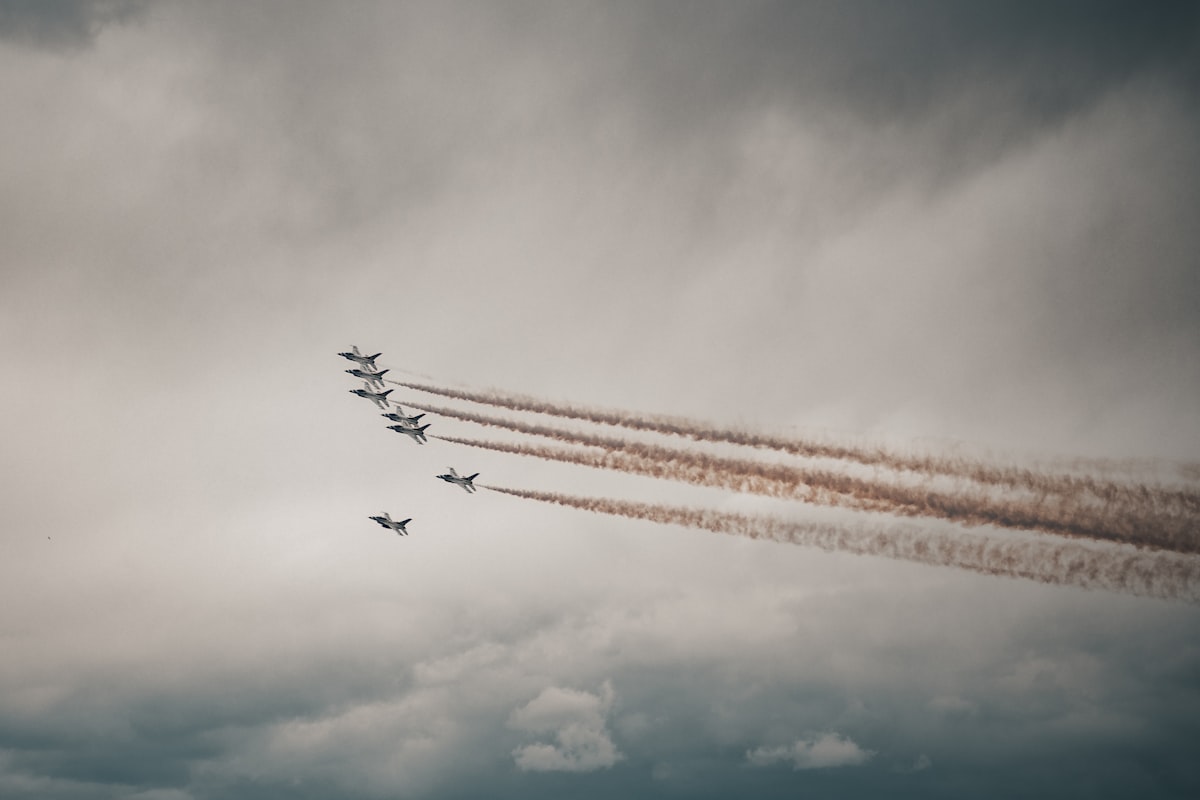How Artificial Intelligence is Used in F-16 Fighter Jets
This article explores the incredible ways AI is being utilized in F-16 fighter jets, including improving detection of targets and advanced navigation systems.

The F-16 fighter jet has been enhanced with a range of (Artificial Intelligence) AI technologies designed to make it more efficient and accurate in its missions. From improved detection of targets to complex automated navigation systems, AI enables the jet to react quickly and accurately in dynamic circumstances.
AI & F-16
In a test with tactical aircraft, AI was utilized to pilot an F-16-inspired plane for more than 17 hours. The aircraft, known as the Variable In-Flight Simulator Test Aircraft (VISTA) X-62A, was modified and furnished with the necessary hardware for the Air Combat Evolution (ACE) program's software to function. The VISTA aircraft was flown by AI algorithms during takeoff and landing.
Photo by Carrie Borden / Unsplash
The Defense Advanced Research Projects Agency (DARPA) initiated the ACE initiative in 2019 with the intention of revolutionizing aerial combat by enabling F-16s to dogfight autonomously. The System for Autonomous Control of Simulation, a recent improvement, allowed the VISTA to test its autonomous F-16 AI. In comparison to human pilots, the AI is anticipated to be able to make tighter turns, take bigger risks, and fire more accurately. If the ACE program is successful, four L-39 aircraft with artificial intelligence capabilities will engage in a real-time duel over Lake Ontario in 2024.
AI flies F-16-inspired jet for 17 hours in first test with tactical aircraft
https://thehill.com/policy/technology/3857914-ai-flies-f-16-inspired-jet-for-17-hours-in-first-test-with-tactical-aircraft/AI Just Flew an F-16 for 17 Hours. This Could Change Everything
https://news.yahoo.com/ai-just-flew-f-16-143000286.html

How AI is Used for Target Detection in F-16 Aircraft
AI is being used to enable the F-16 fighter to detect targets more quickly and accurately than ever before. The AI-powered system utilizes algorithms to quickly identify potential targets from a range of sources such as radar, aerial photographs, and infrared. These systems are then able to assess precisely what type of target it has identified and its size, making targeting much more accurate and efficient.
VISTA X-62 Advancing Autonomy And Changing The Face Of Air Power
https://news.lockheedmartin.com/2023-02-13-VISTA-X-62-Advancing-Autonomy-and-Changing-the-Face-of-Air-Power
AI-enabled F-16s are able to assess patterns in complex data sets more quickly than a human operator and draw more accurate conclusions about targets. AI can also detect targets using more sources of data than ever before, enabling the system to detect anomalies potentially missed by manual monitoring. The implementation of AI in F-16s has drastically improved the targeting accuracy and speed, making the aircraft a formidable foe against enemies on the battlefield.
AI Enhances F-16 Navigational Systems and Flight Decisions
Artificial intelligence can be used to help optimize the navigational system of an F-16 fighter jet. Through AI, advanced flight decisions based on existing data and past experience can be made in real time. This helps pilots make better decisions about potentially hazardous flight patterns which increases overall safety and efficiency during operations. AI also enhances the navigational systems of the jet by providing more detailed information about terrain, weather conditions, and air traffic control instructions.
Furthermore, AI can be used to analyze data from sensors and cameras on the aircraft to inform the pilot of any changes in mapping or survivability initiatives. AI-aided navigation systems can even help pilots navigate around obstacles such as airborne enemies or dangerous terrain. This data can also be used for quickly assessing enemy strategies. Through artificial intelligence, F-16 fighter jets are able to make more effective decisions and better protect personnel deployed on mission with accurate navigation capabilities.
Autonomous Drones Could Share Burden with Fighter Jets
F-16 fighter jets could benefit from the introduction of autonomous drones in their operations. Autonomous drones can help share the burden by scouting ahead and relaying data back to fighter jets. This could help pilots make better informed decisions faster as they will be able to take into account various reconnaissance data that traditional aircrafts wouldn’t have been able to receive. With the advancement of AI, autonomous drones may even be used for automated decision making in combat situations which would further increase operational efficiency and effectiveness.
Such a system already exists in a rudimentary form. For example, the U.S. Air Force’s F-16 fighter jets have one drone called an expendable unmanned aerial vehicle (UAV) that can fly ahead of it and provide real-time reconnaissance data that the pilot can use to make informed decisions in combat zones. The advantage of using autonomous drones is that they can scout larger areas faster and quite safely as they don’t need to worry about potential enemy fire while performing their mission. This could be particularly helpful in search-and-rescue missions where fast response times are critical for saving lives as well as providing more accurate information for precise operation control by fighter jets.
Exploring the Ethical Considerations of Utilizing AI in F-16s
Autonomous drones and AI can provide tremendous efficiencies to military operations, however it is also important to consider the ethical implications of its use. With greater autonomy in decision making, comes significant responsibility and accountability in understanding, utilizing and implementing appropriate conditions for operation. Along with the technical and legal aspects of operating autonomous systems, there is an equally important moral aspect which must be considered when making decisions that could potentially determine life or death. Because of this, it is essential to explore what ethical frameworks should be put into place before implementing autonomous technologies in F-16 jets.
When making decisions with autonomous technology, the AI must be properly trained to meet both ethical and legal standards. AI should also be built to support moral characteristics that traditionally might come from a human decision loophole. In order for this to happen, ethical frameworks must be developed which cover different scenarios in an F-16 mission. These frameworks would specify acceptable levels of autonomy when it comes to making decisions such as the use of force or targeting enemy assets. Additionally, these systems should have control features implemented in the event of a malfunction or oversight so that the situation can quickly be brought back under control within appropriate parameters. With proper consideration and understanding surrounding this topic, autonomous technologies in F-16s can provide great efficiencies yet still maintain acceptable ethical boundaries.
Roadmap for Future Development of AI Capabilities in Jet Fighters
To ensure the best possible ethical framework is put into place when introducing AI capabilities to the F-16 fighters, it is important for governments and military organizations alike to formulate a roadmap for development. This roadmap should take into account the regulations already in place, risks associated with operation of AI technology, safety considerations as well as measures put in place to address moral exigencies. Additionally, research should be done to ensure that pilots are adequately trained and verified to effectively utilize autonomous systems, in order to continually ensure safe and secure operation of fighter jets around the world.
Photo by Mark König / Unsplash
When laying out a roadmap for the future development of AI capabilities in F-16 fighter jets, it is also important to consider potential areas of exploration and research. Technology should be developed to not only replace traditional tasks such as reconnaissance and surveillance, but also use deep learning and artificial intelligence to help pilots better identify potential threats. This can be achieved by training algorithms on real world care scenarios using AI simulation aids that constantly process data acquired from sensors on aircrafts, drones or satellite images. Additionally, automated decision making systems should explored in order to increase flight safety, decrease human workloads or mitigate risks associated with mission execution. Lastly, research should be conducted into utilizing natural language processing capabilities in order to provide pilots with more intuitive command recognition systems
F-16 AI Upgrade
F-16 fighter jets have been upgraded with AI-enabled technology to enhance their combat capabilities. This upgrade involves integrating advanced sensors, algorithms, and machine learning technology to improve the F-16's ability to perform complex tactical maneuvers, detect and track multiple targets, and identify potential threats.
The AI technology enables the F-16 fighter jets to process vast amounts of data and provide critical insights to pilots in real-time, enabling them to make better decisions and respond faster to changing combat situations. With the help of AI, the F-16 fighter jets can also analyze and learn from their past missions, making them more effective and efficient in future operations.
The use of AI in F-16 fighter jets is part of a broader trend of incorporating AI-enabled technology in defense and military applications. The application of AI in fighter jets is expected to play an increasingly important role in future warfare, where speed, agility, and precision are essential to mission success.
F-16 Performance
Lockheed Martin created the multipurpose combat aircraft known as the F-16 Fighting Falcon. It has cutting-edge hardware, including Honeywell color flat-panel multifunction displays, a digital terrain system, a modular mission computer, and color video. It can carry a variety of weaponry and missiles and has an extended structural life of 12,000 hours.
Performance-wise, the F-16 can travel at a top speed of Mach 0.86 and a top height of 55,000 feet per minute. Additionally, it has a 145-knot beginning airspeed (IAS) and a maximum flight speed of 175 knots. The F-16 can accurately deliver ammunition during non-visual bombing conditions and has an air-to-surface range of more than 500 miles (860 kilometers).
F-16 Specifications
A fourth-generation, single-engine, multirole fighter aircraft, the General Dynamics F-16 Fighting Falcon was created by General Dynamics for the US Air Force. Its length is 49 feet 4 inches (15 meters), its wingspan is 31 feet (9.4 meters), and its height is 16 feet 8.5 inches (5 meters).
It weighs 18,280 pounds (8,300 kilograms) at empty and 37,500 pounds (17,000 kilograms) at gross. It has a thrust of 27,000 pounds and is propelled by either a Pratt & Whitney F100-PW-200/220/229 or a General Electric F110-GE-100/129 engine.
A single F-16A/B costs $14.6 million and a single F-16C/D costs $18.8 million in 1998 constant dollars, respectively.
Falcon Forward: A new era of F-16
https://www.lockheedmartin.com/en-us/products/f-16.html
F-16 Range
The F-16A/B and Block 50 versions of the Lockheed Martin F-16 Fighting Falcon have ranges of 575 miles (925 km) and 1,260 miles (2027 km), respectively. Nine hardpoints for armament payloads are installed on the aircraft: one is located at each wing tip, three are under each wing, and one is located in the middle of the fuselage. Additionally, it has a brand-new electronic warfare suite and Northrop Grumman's sophisticated APG-83 AESA radar. The fighter enables interoperability with allies and a service life of 12,000 hours.
F-16 Cost
Depending on the model and the nation buying it, an F-16 Fighting Falcon's price varies. The Block 70 and 72 type, which is the most expensive, can cost up to $63 million per unit. In the 1980s, the F-16A and B were sold for at least $12.7 million each outside of the US. Additionally, operating an F-16C Viper costs about $22,514 per hour, and defense analysts calculate that an F-16's annual maintenance expenditures are roughly $10 million.
F-16 - The American Pride
Due to its lengthy history of duty with the United States Air Force and its crucial role in safeguarding American interests both at home and abroad, the F-16 fighter jet is frequently referred to as the "American Pride." Over 25 nations have utilized the F-16 since it was designed and built in the 1970s by General Dynamics (now Lockheed Martin).
F-16 Fighting Falcon
https://www.af.mil/About-Us/Fact-Sheets/Display/Article/104505/f-16-fighting-falcon/
Photo by Aral Tasher / Unsplash
The multi-role F-16 fighter jet is built to carry out a variety of tasks, including as air-to-air combat, air-to-ground assaults, reconnaissance, and other tactical operations. It is swift, extremely maneuverable, and equipped with a potent arsenal of bombs, missiles, and a 20mm gun.
The Gulf War, the Iraq War, and the War in Afghanistan are just a few of the well-known combat engagements in which the F-16 has taken part. Additionally, NATO and other coalition troops have utilized it in several missions across the globe.
The F-16 fighter jet continues to be a crucial component of the arsenal of the United States Air Force, and its continual development and modifications show just how crucial this aircraft remains to the country's military plans. The F-16 fighter jet is a representation of American military prowess and technological ingenuity, as well as the nation's dedication to upholding international peace and security.
Photo by Osman Rana / Unsplash
You'll like learning about the F-22 Raptor and how it contrasts with the SU-57.
One of the most sophisticated and effective fighter jets in the world is the fifth-generation F-22 Raptor stealth fighter. It can carry out many different tasks, such as air-to-air warfare, air-to-ground assaults, intelligence collection, and observation.
The F-22 is outfitted with cutting-edge technologies, such as radar-evading stealth, supercruise speed, and sophisticated sensors and avionics that let it find and follow targets at a distance. Additionally, it has modern weapons including air-to-air missiles and explosives.
As well as air policing, combat search and rescue, and combat operations in Iraq and Syria, the F-22 has been deployed in a number of other activities. It has also been deployed to support ground forces and carry out intelligence collecting operations.
Due to its cutting-edge characteristics and capacity for operation in situations of intense competition, the F-22 is regarded as a future star. It is made to function in the most difficult and dangerous circumstances, especially in opposition to sophisticated air defense systems.
The F-22 continues to be a key asset for the United States and has raised the bar for air superiority. Armory of the Air Force. The F-22 Raptor continues to play a significant role in U.S. defense policy as evidenced by its cutting-edge capabilities and continuous upgrades.
Photo by Anna B. Meyer / Unsplash








